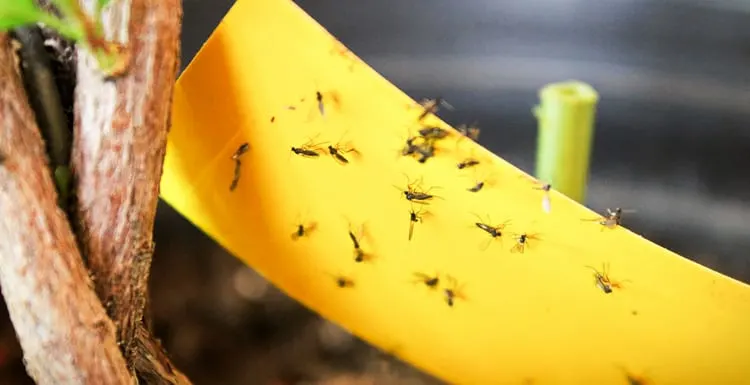Wondering how to get rid of gnats? If so, you’re in the right place.
Our complete guide covers what gnats are, their favorite environments, and how to get rid of them.
Read on to learn all you need to know.
We partnered with Networx to help you find local pest control techs. Click to below to get a FREE quote.
What Are Gnats?

Gnats are one of the peskiest insects to have in your home. They’re tough to eliminate because they breed so often. They always seem to fly directly in your face or make an appearance when you have guests over.
Whether they’re hanging out in your kitchen, shower, or potted plants, we’ll show you how to get rid of gnats with proven effective methods.
To get rid of gnats, you need to know a little about these flying insects, what they eat, where they breed, and what environments they like.
They Aren’t One Species
Gnats aren’t a single species. The term gnat applies to a wide range of very small, winged insects. There are several different species considered gnats, but in general, gnats are dark brown or black.
And they have slender bodies about 3/16” to ⅛” in length, long legs, and skinny wings. Gnats do fly, but they’re not very good at it.
This is why you’ll often see them resting on surfaces in the areas they feed and breed in. To find out the best way to nix your gnat problem, you need to know which type of gnat you’re dealing with.
Types of Gnats
There are several types of gnats around the world. In general, gnats will either be biting or non-biting species. Three types of gnats will infest a home, and all are non-biting:
- Fruit flies
- Fungus gnats
- And drain flies
Use this information to identify the gnats in your home to find the most effective treatment method to get rid of them.
Fruit Flies
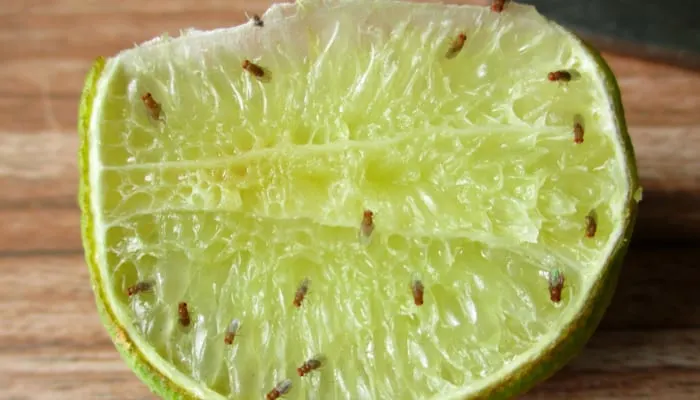
Supapornkh/Shutterstock
- Size: 1/8” – 3/16”
- Preferences: Fresh and rotting food, sugar, vinegar, alcohol
- Where: Usually in the kitchen
Fruit flies (also called vinegar flies) are among the most common gnat types you’ll find in your home. As the name indicates, you’ll find them hanging out around fresh and rotting fruit, sugar, and alcohol.
They’re even attracted to vinegar. Fruit flies are very small, with bodies about 1/8” to 3/16” long. They look like tiny house flies. Look for fruit flies in trash bins, garbage disposals, open drinks, and fruit bowls.
Fungus Gnats
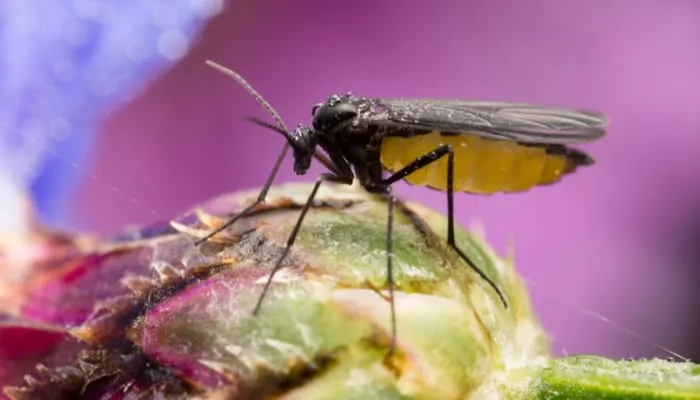
Henrik Larsson/Shutterstock
- Size: Less than 1/8”
- Preferences: Moist or wet areas, soil
- Where: Usually found in and around potted plants
If you see gnats hovering around or in the soil of your potted plants, they’re probably fungus gnats. Fungus gnats are tiny flies that look more like mosquitoes.
They have dark wings with a telltale Y-shape wing vein and eat fungus, leaf mold, mulch, grass clippings, compost, and roots. They’re harmful to potted plants because of the damage they cause to the root systems.
Adult female fungus gnats lay eggs in potting soil where the larvae will be protected as it matures. Even after using sticky traps to get rid of fungus gnats, more will appear as the larvae mature in a few days.
Fungus gnats don’t like dry or well-draining soil. If you have a habit of overwatering your plants or if your pots don’t have adequate drain holes, fungus gnats can quickly become a problem.
Drain Flies
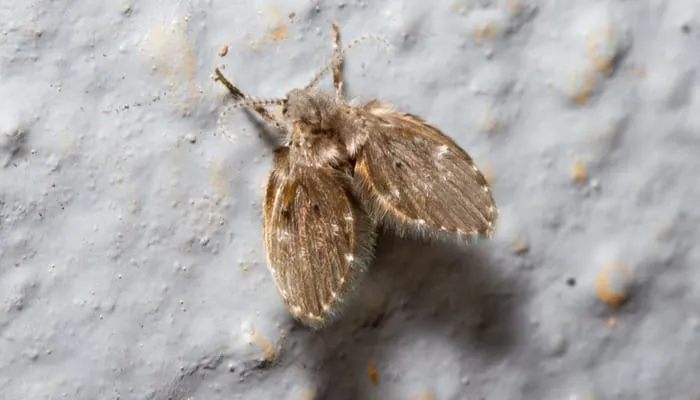
JorgeOrtiz_1976/Shutterstock
- Size: About 1/8”
- Preferences: Damp, dark areas
- Where: Usually in the bathroom or kitchen
Drain flies (also called sewer flies or filter flies) look like moths. They like damp, dark areas, so drains, sink overflows, and plumbing are their favorite environments.
They might be found in kitchen or bathroom sink areas. These gnats lay their eggs in any buildup or sludge inside the drain or in standing water. Drain flies aren’t just annoying – they are problematic inside a home.
Their fuzzy bodies disintegrate when they die, and the resulting dust is known to aggravate asthma symptoms or cause bronchial asthma. Most disturbingly, drain fly larvae can cause myiasis.
This means their larvae can opportunistically enter human or animal tissue through a wound or orifice to grow into an adult drain fly.
To avoid any potential issues like these, it’s important to know how to quickly get rid of gnats. We’ll share the most effective methods below.
How to Get Rid of Gnats
The method you’ll use to get rid of a gnat infestation depends on the type of gnat you’re dealing with. Below, we list the best methods to eliminate each type of gnat and take measures to make sure they don’t come back.
Getting Rid of Fruit Flies
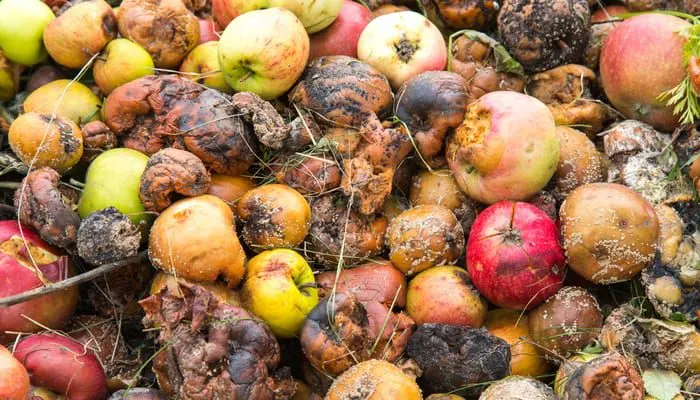
Paul D Smith/Shutterstock
Getting rid of fruit flies starts with getting rid of their favorite food sources and breeding grounds. The tips below are all recommended by pest control companies to get rid of fruit flies.
- Remove any overripe or rotten fruit from your kitchen. Double bag it and dispose of it in an outdoor trash bin.
- Store any undamaged fruit in your refrigerator until the infestation is gone.
- Don’t throw food scraps, fruit or vegetable peels, or any organic matter away inside your home. Dispose of it outside.
- Clean your garbage disposal and kitchen sink with a drain cleaner or bleach to get rid of any organic matter that may be inside. This is where the fruit flies may be laying eggs.
- Clean the inside of your trash bin to ensure there is no sugar, alcohol, or organic matter, attracting fruit flies under your garbage bag.
- Check the area for standing water or excess moisture that may attract fruit flies.
- If you don’t already have one, get a trash bin with a lid that closes.
- Use a store-bought fruit fly trap to attract and trap adult flies. You can pick these up at most stores or online for anywhere from $5 for basic traps to about $40 for UV traps.
- Use an aerosol insecticide like pyrethrin to kill remaining adult fruit flies after their food source has been removed.
Getting Rid of Fungus Gnats
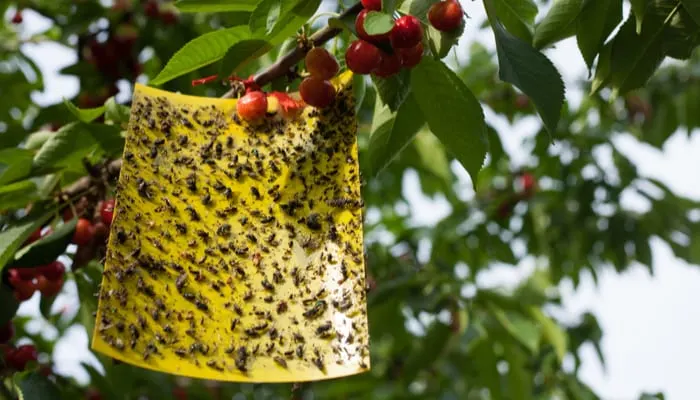
Andras_csontos/Shutterstock
Fungus gnats can be eliminated with different methods. Because they lay eggs in soil, if fungus flies are inside your home, you likely have potted plants inside or bags of soil you’re planning to use outside.
Here are methods that will get rid of fungus gnats:
- Use the natural insecticide Bti (Bacillus thuringiensis subspecies israelensis) in the form of Mosquito Bits or Gnatrol sprinkled into the soil of affected plants. The larvae will feed on it and die.
- Use yellow sticky traps to trap adult fungus gnats around plants. Try cutting the traps into smaller squares and elevating them above the soil with skewers or sticks.
- Hang sticky traps near windows and light sources. Gnats are attracted to light.
- Water your houseplants with 1 part hydrogen peroxide (3%) and four parts water. The hydrogen peroxide kills fungus gnat larvae on contact but won’t harm your plants.
- Allow potting soil to dry out a bit in between watering. Make sure all your pots have adequate drain holes.
- Use a small trowel to turn over the top few inches of soil in your potted plants. This exposes any gnat larvae to air and helps the soil dry faster.
- Get into the habit of “baking” any new potting soil in a 250-degree oven for at least 30 minutes to kill any gnat larvae that may be hiding there. Just spread the potting mix as thinly as you can on a large baking tray and cover with foil, even if you need to do multiple batches.
- If any plants are severely infested, and none of the above methods work, you may need to toss out the soil and thoroughly rinse the plant’s roots before repotting in a clean, sterile pot with fresh soil.
- As a last resort, throw severely infested plants out.
Getting Rid of Drain Flies
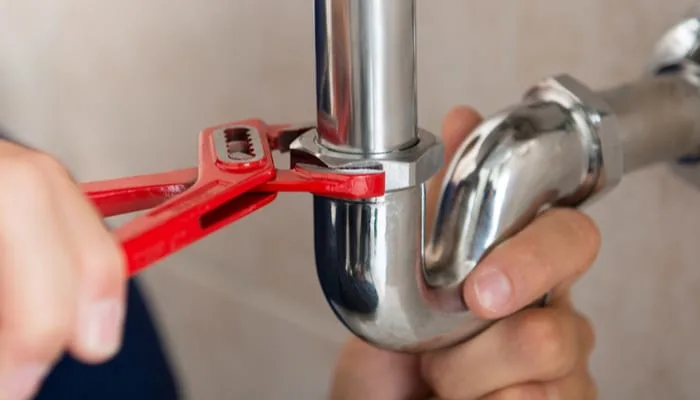
Rido/Shutterstock
Drain flies can cause problems from asthma to myiasis (when fly larvae enter a human body). Getting rid of drain flies starts with targeting their preferred environment: Damp, dark drains.
- Put clear tape over any drain that you suspect drain flies may be entering and breeding in. Leave it overnight and check to see which drains are the source.
- Check any exposed plumbing for leaks and fix them. Drain flies love moisture and need it to breed.
- Use a gel drain treatment that clings to the inside of pipes to kill larvae and drain flies inside your drains. One option is Green Gobbler, a natural gel drain treatment made with citronella oil. After using, place a bowl or cup upside down over the drain to trap any flies that try to escape.
- After using the gel drain treatment, flush the drain by pouring hot water down the drain to remove any sludge (where drain flies breed) that was left behind.
- Hang sticky traps in the areas you see drain flies to trap the adults and prevent them from laying more eggs.
- Look for standing water in your shower or bathtub and dry it thoroughly. If you have standing water in a potted plant’s saucer, remove it.
- Use an aerosol insecticide spray to target and kill any remaining adult drain flies. It’s important to kill any adults you see to prevent them from laying more eggs.
- Keep your drains clean and try to keep your shower, tub, and sinks dry in between uses.
How to Prevent Gnats from Coming Back

Flystock/Shutterstock
Battling gnats is annoying. But there’s nothing worse than a resurgence after you finally got rid of them. You can prevent gnats from coming back by purposefully eliminating their favorite environments and foods.
To prevent fruit flies from coming back into your home, don’t buy excess fruit. Buy just enough that you’re sure will be eaten within a day or two.
If you don’t plan to use fruit quickly, try putting it in the refrigerator to keep it from attracting fruit flies. Dispose of rotting fruit and food scraps outside, never in your trash bin.
Keep your garbage disposal and drains clean, as fruit flies may hang around these areas in search of fruit or vegetable scraps to feed and breed on.
Take the trash out often to avoid letting refuse inside become attractive to fruit flies. After all, if you get rid of the source of food, they’ll have no reason to enter your home.
To prevent fungus gnats from coming back, don’t overwater your houseplants. Keep the top few inches of the soil relatively dry by bottom-watering instead.
Do this by adding water to a dish under the plant and soaking up the water. Make sure to dump any remaining water from the dish after the plant has had time to soak it up.
Sprinkle Mosquito Bits in your potting soil now and then to make it impossible for gnats to breed there. Cover and bake any new soil in a 250-degree oven for at least 30 minutes to kill larvae.
To prevent drain flies from coming back, make a habit of regularly cleaning your drains (shower, bathtubs, sinks) and garbage disposals.
Don’t allow sludge to build up and create a favorable breeding ground for drain flies. Run your bathroom exhaust fan while showering for 15 minutes afterward.
This removes excess moisture and water vapor. Leave the shower curtain or door open after bathing to give any remaining moisture a chance to evaporate.
Call a Pro
If you’ve tried all of our DIY solutions and still have gnats in your house, it’s time to call a professional. After all, they have the experience and chemicals to treat the problem once and for all.
To connect with a local pest control expert, simply click the green button in the box below and enter some basic information. You’ll be paired with a few local vendors for a free quote. Yes, it really is that easy!
We partnered with Networx to help you find local pest control techs. Click to below to get a FREE quote.
Still Wondering How to Get Rid of Gnats?

Wavebreakmedia/Shutterstock
Still wondering how to get rid of gnats? We hope not. Our complete guide should have covered the steps to take to make your house insect-free.
In any case, gnats of all types are unwelcome houseguests. You can keep them from staying too long by taking action with the gnat-eliminating tips we shared as soon as you see them.
Prevent them from taking up residence in your home again by employing preventative measures that make your house inhospitable for them:
- Removing their breeding grounds
- Taking away favorite foods
- And removing preferred environments
Your home will be so much more enjoyable once you send the gnats packing. On a side note, if you liked this article, check out some of our other helpful guides by clicking one of the links below.
Resources:

